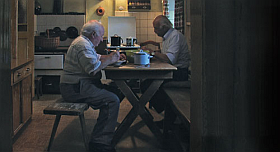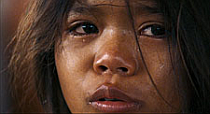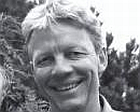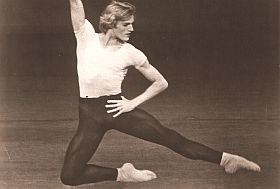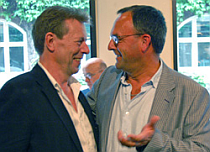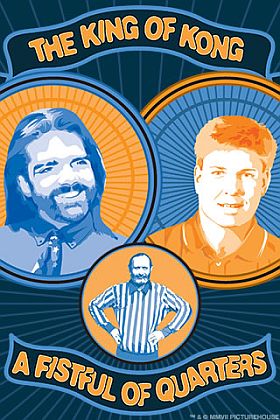


Jørgen Leth: Notater om kærligheden
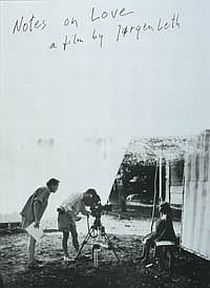
I morgen aften skal vi se en gammel Jørgen Leth film i min filmklub. Jeg har prøvet at forberede mig. Det kan jeg ikke, jeg farer vild, eller det mærkes som om jeg gør det. Landskaberne og opstillingerne fører tilsyneladende så mange steder hen. Som hele tiden ligner det forrige. Men jeg tager fejl, imidlertid tager jeg fejl. Der er forskydninger, små umærkelige ændringer. Det er ikke blot smukke postkort med tekst bagpå vist efter hinanden (selv om det for så vidt havde været fint nok, når fotograferne er Henning Camre og Dan Holmberg, og det er Jørgen Leth, som har skrevet de korte tekster, som hører til), nej der er en evig kadance, en stigning i intensitet, viden og overblik, små fald og stigninger undervejs (det er skam levende dette) men generelt en ubrydelig udvikling frem mod en stor tilfredsstillelse: klogskab og skønhed forenet i en fejlfri film.
I aften skal vi se en gammel Jørgen Leth film. Jeg har prøvet at forberede mig. Det kunne jeg ikke, jeg for vild, eller det mærkedes som om, jeg gjorde det, da jeg så filmen igennem. Landskaberne og opstillingerne fører tilsyneladende så mange steder hen. Som hele tiden ligner det forrige. Jeg tog fejl… Imidlertid tog jeg fejl. Der er forskydninger, små umærkelige ændringer. Det er ikke blot smukke postkort med tekst bagpå vist efter hinanden (selv om det for så vidt havde været fint nok, når fotograferne er Henning Camre og Dan Holmberg, og det er Jørgen Leth, som har skrevet de korte tekster, som hører til), nej der er en evig kadance, en stigning i intensitet, viden og overblik, små fald og stigninger undervejs (det er skam levende dette) men generelt en ubrydelig udvikling frem mod en stor tilfredsstillelse: klogskab og skønhed forenet i en fejlfri film.
Filmen, vi skal se er Notater om kærligheden fra 1989 som jeg har valgt, nu vi venter på Det erotiske menneske, som blev forsinket af al balladen. Der var også ballade for tyve år siden. Jørgen Leth var også dengang sin egen, han lavede ikke de andres film, ikke de film man ønskede, han lavede igen sin egen film, og som Lasse Ellegård bagefter skrev “…rygtet løb i forvejen. Jørgen Leth har lavet en filmatisering af sit privatliv, lød meldingerne i miljøet. Kritikken var varskoet. Og dommen faldt med forudsigelig præcision. En enig dagbladskritik var unison. Den så kun Notater om kærligheden som det endegyldige udtryk for instruktørens manierede krukkeri, hans narcissistiske selvspejling, hans patetiske privatisme.”
Lasse Ellegaard ser noget helt andet. Han ser den antropologiske film: “… I Notater om kærligheden rendyrker han sit udtryk, som er afsøgning af overflader, signalementer af konkrete ting og handlinger. Hans udfordring har været at konkretisere en følelse, men den største følelse af alle: Kærligheden.” Ellegaard sammenfatter i sin overskrift “en mesterlig film.” Jeg er fuldstændig enig.
CITATSAMLING TIL FILMAFTENEN
Den anden uskyld Poul Borum: Poetisk Modernisme, 1966. (Stykket har jeg ændret, så det fra at handle om tekster her handler om film): “Det trænede filmpublikums ideelle dvd-gennemsyn og arbejde med filmen bør se således ud: 1) opleve filmen umiddelbart og uhildet, 2) nærme sig filmen fra så mange sider som man kan overkomme og med så megen viden og indsigt som muligt – den eneste gyldige metode er den pluralistiske – dvs. at forstå og vurdere alle detaljer og deres sammenhænge og helheder: filmens billede og lyd, dens ord, dens locations og personer, afsnit og scener, dens motiv og holdning og genre, dens helhed – og filmens placering midt i sine kontekster, trådene ud til psykologiske, sociale, historiske, litterære og filmiske sammenhænge, alt det tidsbetingede i den tidløse enestående film. 3) Når dette er nok, da: at glemme det hele og opleve filmen igen, i dén anden uskyld som er både forståelse og oplevelse, som er kunstværkets mening og hensigt…”
(Som altid, når jeg er forvirret følger jeg strikt Borums gamle opskrift. Og her er så lidt til en begyndelse på at nærme sig filmen fra så mange sider som jeg har kunnet nå til nu…)
Malinowski er min helt Den Store Danske Encyklopædi: “Mali’nowski, BronisHaw, [-gNCf-], 1884-1942, polsk-britisk antropolog. Under sit ophold på øgruppen Trobrianderne ved Ny Guinea under 1. Verdenskrig udviklede Malinowski feltarbejdet som antropologisk metode. Han lagde vægt på deltagerobservation, hvor forskeren i længere tidlever i det udforskede samfund og deltager i det daglige liv. Hans vigtigste værker beskriver øhavets handelssystem kula, trobriandernes seksualliv og deres havebrug. Han vendte sig mod kulturhistoriske teorier og var fortaler for funktionalismen. For ham bestod et samfund som trobriandernes af en række institutioner som fx ritualer, ægteskab og kula. Deres funktion opfattede han på to måder: Dels bidrog de til at vedligeholde samfundet som helhed, dels opfyldte de den enkeltes behov. Hans teorier inspirerer ikke længere antropologien, men hans feltmetode værdsættes stadig.”
(… i hvert fald må jeg vide lidt mere om denne Malinowski, hvis fotografier indgår, som selv er på billederne, som Jørgen Leth beundrer siden han læste antropologi på universitetet hos professor Johannes Nicolaisen)
Leths selviscenesættelse Søren Birkvad: Verden er leth, 1992: “… Billederne af naturbefolkningen på New Guinea, der glimtvis dukker op som små portrætarrangementer af indfødte, der pynter og smører sig, ryger og spiser, er efter min mening lovlig tæt på den voyeuristiske overfladiskhed, man kender fra safari-serier i mondæne magasiner. I samme forbindelse virker Leths selviscenesættelse som negerinstruktør i khakifarvet Stanley-dress som en (tilsigtet?) perspektivforkortelse: det er som vanligt det han gør ved stedet, mere end stedet selv, vi fæster os ved. De mange scener med filmfolk, der filmer sig selv filme, er sigende: filmen handler om en film, der ikke kan samle sig om noget andet end sit eget forsøg på at blive til.”
(… og filmvidenskabsmanden er om muligt i sin fremstilling næsten mere perfid end anmelderne)
Institutionens funktion Den Store Danske Encyklopædi: “Funktionalistisk antropologi. Funktionalismen har fra 1920’erne til 1950’erne især præget britisk socialantropologi. Den blev her udviklet af B. Malinowski og A.R. Radcliffe-Brown, som begge var påvirket af É. Durkheim. De fremhævede studiet af elementer i deres samtidige sammenhæng i modsætning til det historiske studium af deres oprindelse og spredning. Begge betragtede fænomener som integreret i en større helhed. For Malinowski var en institutions funktion dens bidrag til tilfredsstillelsen af menneskelige behov.”
(… Jeg tror dette er et strejflys på instruktørens teoretiske fundament, støbt på studiet før marxisterne ankom.)
Mennesker, som jeg sætter højt Max Kestner i Ekko 38/2007: …En anderledes tung stemning finder man i Notater om kærligheden. Jeg ved, at mennesker, som jeg sætter højt, holder meget af den film, men den er ikke øverst på min liste.
(… Leths meget yngre kollega og humorist foretrækker altså de morsomme film i dvd-boksen, Det perfekte menneske og De fem benspænd)
Se, det her kan jo fortsættes. Og så glemmer man det hele og ser filmen i en ny uskyld.
Danmark, 1989, 90 min. På dvd i bokssættet The Jørgen Leth Collection, 2007

